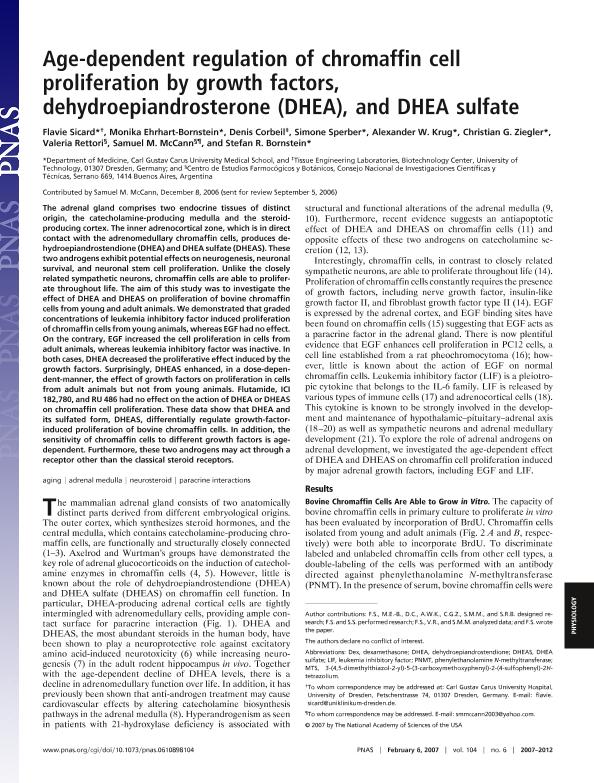Artículo
Age-dependent regulation of chromaffin cell proliferation by growth factors, dehydroepiandrosterone (DHEA), and DHEA sulfate
Sicard, Flavie; Ehrhart Bornstein, Monika; Corbeil, Denis; Sperber, Simone; Krug, Alexander W.; Ziegler, Christian G.; Besuhli, Valeria ; McCann, Samuel M.; Bornstein, Stefan R.
; McCann, Samuel M.; Bornstein, Stefan R.
 ; McCann, Samuel M.; Bornstein, Stefan R.
; McCann, Samuel M.; Bornstein, Stefan R.
Fecha de publicación:
12/2007
Editorial:
National Academy of Sciences
Revista:
Proceedings of the National Academy of Sciences of The United States of America
ISSN:
0027-8424
Idioma:
Inglés
Tipo de recurso:
Artículo publicado
Clasificación temática:
Resumen
The adrenal gland comprises two endocrine tissues of distinct origin, the catecholamine-producing medulla and the steroid-producing cortex. The inner adrenocortical zone, which is in direct contact with the adrenomedullary chromaffin cells, produces dehydroepiandrostendione (DHEA) and DHEA sulfate (DHEAS). These two androgens exhibit potential effects on neurogenesis, neuronal survival, and neuronal stem cell proliferation. Unlike the closely related sympathetic neurons, chromaffin cells are able to proliferate throughout life. The aim of this study was to investigate the effect of DHEA and DHEAS on proliferation of bovine chromaffin cells from young and adult animals. We demonstrated that graded concentrations of leukemia inhibitory factor induced proliferation of chromaffin cells from young animals, whereas EGF had no effect. On the contrary, EGF increased the cell proliferation in cells from adult animals, whereas leukemia inhibitory factor was inactive. In both cases, DHEA decreased the proliferative effect induced by the growth factors. Surprisingly, DHEAS enhanced, in a dose-dependent-manner, the effect of growth factors on proliferation in cells from adult animals but not from young animals. Flutamide, ICI 182,780, and RU 486 had no effect on the action of DHEA or DHEAS on chromaffin cell proliferation. These data show that DHEA and its sulfated form, DHEAS, differentially regulate growth-factor-induced proliferation of bovine chromaffin cells. In addition, the sensitivity of chromaffin cells to different growth factors is age-dependent. Furthermore, these two androgens may act through a receptor other than the classical steroid receptors.
Archivos asociados
Licencia
Identificadores
Colecciones
Articulos(CEFYBO)
Articulos de CENTRO DE ESTUDIOS FARMACOLOGICOS Y BOTANICOS
Articulos de CENTRO DE ESTUDIOS FARMACOLOGICOS Y BOTANICOS
Citación
Sicard, Flavie; Ehrhart Bornstein, Monika; Corbeil, Denis; Sperber, Simone; Krug, Alexander W.; et al.; Age-dependent regulation of chromaffin cell proliferation by growth factors, dehydroepiandrosterone (DHEA), and DHEA sulfate; National Academy of Sciences; Proceedings of the National Academy of Sciences of The United States of America; 104; 6; 12-2007; 2007-2012
Compartir
Altmétricas



